
The Delhi Government has announced a major transformation in its public transport system by renaming the Mohalla Bus Service to ‘Namo Bus’ and introducing 200 new electric buses starting April 1, 2025. This initiative aims to improve last-mile connectivity and provide eco-friendly transportation in congested areas of the city.
The renaming aligns with the government’s larger rebranding strategy of public services, similar to the recent change of Mohalla Clinics to Ayushman Arogya Mandir.
Delhi Government Renames Mohalla Bus Service
| Feature | Details |
|---|---|
| Service Name Change | Mohalla Bus Service renamed to Namo Bus |
| Launch Date | April 1, 2025 |
| New Buses Introduced | 200 Electric Buses |
| Total Buses Expected | 2,000 by 2026 |
| Objective | Last-mile connectivity & reduced congestion |
| Eco-Friendly Transport | 100% electric, zero emissions |
| Smart Features | GPS, CCTV surveillance, Wi-Fi, Panic buttons |
| Official Website | Delhi Transport Corporation |
The Delhi government’s decision to rename the Mohalla Bus Service to ‘Namo Bus’ and introduce 200 electric buses is a transformative step for the city’s public transport. It aligns with sustainability goals, reduces pollution, and enhances connectivity in densely populated areas.
Despite some challenges, the Namo Bus initiative holds immense potential to revolutionize urban transportation in Delhi. As the city moves towards clean energy adoption, this initiative could set an example for other metropolitan regions in India.
What is the ‘Namo Bus’ Initiative?
The ‘Namo Bus’ initiative is a significant step towards enhancing urban mobility in Delhi. It focuses on small and medium-sized electric buses that can navigate through narrow lanes and high-traffic areas, making public transport more accessible for residents.
This project is a part of the broader Delhi Electric Vehicles (EV) Policy, which aims to shift towards a greener and more sustainable public transport system.
Why the Name Change?
The renaming of Mohalla Bus Service to ‘Namo Bus’ follows the trend of rebranding public services in the capital. The name “Namo” is widely associated with Prime Minister Narendra Modi, which some speculate is a political move. However, the government maintains that the name represents progress and development.
Benefits of the ‘Namo Bus’ Initiative
1. Eco-Friendly and Sustainable Transport
One of the biggest advantages of the Namo Bus service is its zero-emission electric buses.
- These buses do not produce harmful pollutants, reducing air pollution in Delhi, which is ranked among the most polluted cities globally.
- The electric buses will contribute to the Delhi government’s clean energy transition, aligning with its goal of 25% electric vehicle adoption by 2026.
2. Smart and Tech-Enabled Buses
The new Namo Buses are equipped with:
- GPS Tracking for real-time location updates.
- CCTV Surveillance for enhanced passenger safety.
- Wi-Fi Connectivity for a seamless travel experience.
- Panic Buttons & Women Safety Measures to ensure secure public transport, especially for female passengers.
- Automated Fare Collection to promote digital payments and faster boarding.
3. Enhanced Last-Mile Connectivity
- Smaller bus sizes make it easier to reach narrow lanes and crowded areas where larger buses struggle.
- Improved public transport accessibility will reduce reliance on private vehicles and auto-rickshaws.
- More frequent services will cut down waiting times and improve commuter convenience.
4. Reduction in Traffic Congestion
- The introduction of 200 electric buses will help reduce congestion by offering an alternative to private transport.
- These buses will operate on high-demand routes, improving the overall efficiency of the public transport system.
5. Affordable Public Transport
- Fares for the Namo Bus will remain affordable, encouraging more people to opt for public transport over private vehicles.
- The government is also planning subsidies and discounts for students, senior citizens, and daily commuters.
What Routes Will the ‘Namo Bus’ Cover?
The 200 electric buses will be deployed in densely populated areas, ensuring better last-mile connectivity. Some of the initial routes include:
- Chandni Chowk to Kashmere Gate
- Lajpat Nagar to South Extension
- Dwarka Sector 21 to Janakpuri
- Noida Sector 18 to Connaught Place
- Saket to Malviya Nagar
The Delhi Transport Corporation (DTC) and the Delhi Integrated Multi-Modal Transit System (DIMTS) will oversee the operations, ensuring seamless service.
Challenges and Potential Roadblocks
While the initiative is promising, it faces some challenges:
- Infrastructure Limitations: Delhi needs more charging stations for electric buses to ensure uninterrupted service.
- Maintenance & Costs: Electric buses have higher upfront costs, although they promise lower operational expenses over time.
- Traffic & Road Conditions: Navigating congested areas remains a challenge, requiring better road management and traffic regulations.
Frequently Asked Questions (FAQs)
1. What is the Namo Bus initiative?
The Namo Bus is a rebranded version of the Mohalla Bus Service, aimed at improving last-mile connectivity in Delhi using electric buses.
2. When will the Namo Bus service start?
The service will officially launch on April 1, 2025, with 200 electric buses in the first phase.
3. Why did the Delhi government rename the Mohalla Bus Service?
The government states that the renaming represents progress and development. However, some believe it is a political move.
4. How many buses will be introduced under the Namo Bus scheme?
Initially, 200 electric buses will be introduced. The Delhi government aims to add 2,000 buses by 2026.
5. How is the Namo Bus service eco-friendly?
These buses are 100% electric, meaning they produce zero emissions, helping to reduce Delhi’s air pollution and carbon footprint.
6. What areas will the Namo Bus service cover?
The service will focus on densely populated areas such as Chandni Chowk, Lajpat Nagar, Dwarka, Noida, and South Delhi.







